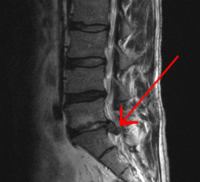
Photo from wikipedia
BACKGROUND Horner's syndrome is an infrequently seen complication of anterior cervical discectomy and fusion (ACDF). Multicenter studies have reported a very low incidence, less than 0.1%. OBJECTIVE To identify the… Click to show full abstract
BACKGROUND Horner's syndrome is an infrequently seen complication of anterior cervical discectomy and fusion (ACDF). Multicenter studies have reported a very low incidence, less than 0.1%. OBJECTIVE To identify the incidence and characteristics, as well as the postoperative course, of patients who develop postoperative Horner's syndrome after ACDF METHODS: We performed a retrospective review of all patients that developed Horner's syndrome after ACDF for cervical degenerative disease at a single tertiary care institution between 2017 and 2018. A systematic review was then performed to identify studies investigating prevalence, diagnosis, and treatment of postoperative Horner's syndrome after ACDF. RESULTS Of 1116 patients at our institution who underwent ACDF, incidence of Horner's syndrome was 0.45%. C4-5 and C5-6 were the two most common surgical levels. The complication was noted to occur immediately after surgery, and at least partial improvement was identified in all patients an average 3.5 months following surgery (range 10 days to 6 months). These findings were consistent with our systematic review of 21 studies that showed an incidence of 0.6% (range 0.02 - 4.0%) with the most common surgical level C5-6 (64%), and 82% experiencing at least partial resolution of symptoms within one year (60.7% complete, 21.4% partial resolution). CONCLUSION Horner's syndrome occurs in 0.6% of patients undergoing ACDF. Careful postoperative examination should reveal this complication, which may be under-diagnosed or under-reported in larger multicenter case series. The majority of patients experience complete resolution of symptoms within 6 months to 1 year and can be managed conservatively and expectantly.
Journal Title: World neurosurgery
Year Published: 2019
Link to full text (if available)
Share on Social Media: Sign Up to like & get
recommendations!